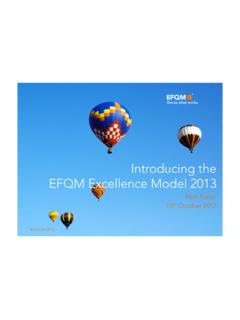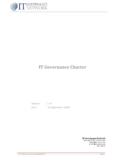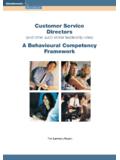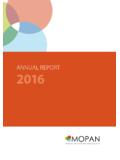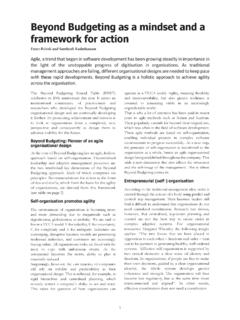Transcription of PUMA - entreprise Agile
1 Agile Enterprise Architecture puma . Architecture of a generation of high-performance enterprises Jean-Pierre Vickoff Teamlog Architecture d' entreprise Agile Agile Enterprise Architecture Table of Contents Vectors of Enterprise Dynamics .. 3. "Service" Orientation and "Business" Process .. 3. Action Space and Temporal 5. Incrementally Iterative Solutions 5. Multi-Concern Global Vision .. 6. The Governance Aspect .. 7. The Theory of Agile Quality .. 7. The Agile dimensions of change .. 7. Survey of Compositions of Agile Solutions .. 7. Services: Identification and Granularity .. 9. Documentation And Theories Of "Spaces" .. 10. Turn-Key 10. Extreme Agility In Development 11. The Agile Solution Space .. 11. Foundations of Agile Development .. 11. The puma Project Engine .. 13. A Globalist Paradigm .. 15. Agile Enterprise Manifesto .. 15. The puma Agile Enterprise Framework .. 15. For A Free 15. _____. Jean-Pierre Vickoff, Teamlog 2. Architecture d' entreprise Agile Agile Enterprise Architecture An organization is functionally Agile when its operational components (human resources, operational processes, information and technological systems) collaborate in synergy (formalized and instrumented) anticipating or collecting change with the purpose of dynamically compensating for it, then integrating it.
2 The Agile organization is thus a community which continuously regulates its processes. In this context, Agility means efficiency for the immediate future on the basis of action led pragmatism pushed to the extreme. According to the Gartner Group, the Agile company must be Real-time, service- oriented and event-controlled . Vectors of Enterprise Dynamics "Service" Orientation and "Business" Process A well performing Company is "service oriented". The source of its actions is in alignment with the requirements of its customers. Its means are the performance and the quality of its processes. As for the concept of agility, it sticks to a set of values optimizing the implementation of the components of this goal. In order to be Agile , the company must continuously control the dynamics of the evolution of its business process, human resources and information system. At this level, agility requires a projection into the future which must be instrumented via formal techniques, such as rational anticipation.
3 This practice makes it possible to anticipate the dimension of emerging technological or functional developments and their foreseeable impacts on the components of the organization. _____. Jean-Pierre Vickoff, Teamlog 3. Architecture d' entreprise Agile Figure 1. Agile Enterprise Model ( puma Architecture). To understand the architecture of the company on the basis of formal modeling is an essential precondition to any form of action in the process field. On the other hand, it should be obvious that it is useless to seek the key of evolution in an approach centered on the structure of the IS. The answer is not in the structure but in the dynamics of the process. More precisely in a double dynamics: the first, in the present, is an immediate reaction of operational adaptation of the process ;. the second, in the immediate future, is a rational anticipation of technological and functional developments. The first concern of the Agile enterprise is to strategically model customer requirements.
4 This formalization includes the state, at present and in the immediate future, of the technological solutions likely to trigger an operational response. The second necessary tool is a modeling of the business process. It makes it possible for the organization to formalize the processes having to support its missions. It is only then that the concept of technical architecture appears which is applied to an information-processing system or to an industrial production system. On this last point, regarding information systems, the two currently dominant technological orientations are: processes instrumentation (BPM) by means of an independent functionalities orchestration engine, as well as the architecture of design and implementation of these functionalities (SOA). In the world of architectural framework buzzwords reigns the greatest inaccuracy. The absence of global vision in the case of the data processing specialists is certainly the cause.
5 Their proposals are currently limited to technical or applied aspects of an information system. This vision of urbanization that they describe as Company disregards the modeling of competencies, motivations and types of collaboration authorized with human resources and neither does it imply an anticipatory model of the environment in evolution. _____. Jean-Pierre Vickoff, Teamlog 4. Architecture d' entreprise Agile Action Space and Temporal Aspect Moreover, even at the level of the IS, the approaches are dramatically static and mono temporal. At same time, for the Company to be Agile , it must operationally combine the tensions created by the differences between a present of constraints, a past of structures and a future of emergences. In a simple and exhaustive answer, the Process for the Urbanization of Agile Methods ( puma ). materializes the action space where these multiple tensions are being expressed, managed and anticipated. In this approach, the dynamics of company evolution are structured in 6 models (figure 1) that improve upon the "Gartner Architecture for Real Time Reactive Exchange" reference structure.
6 A. more complete version is published in "Syst mes d'information et processus Agile (Herm s, 2003)". Incrementally Iterative Solutions Approach This Enterprise Architecture offers at last a formalized and justified answer to the question According to what and how must we change the process, the IS as well as competences of our human resources . The dynamics of these principles is detailed on ; On its own, the " Agile Solution" (Business Projection) model structure is given by 4 classes of concerns, characteristic of the new Expression of Requirements. Indeed, the stratification of the traditional approaches was not only completely upset in its levels of abstraction, it conceded its place to a multidimensional holistic approach perfected on multiple levels during an incrementally iterative refinement. Nevertheless, these aspects are explored in a fundamental order. On the other hand - all the relative complexity of this operation and its relevance reside in this principle - they must be globally anticipate in an iterative way, in order to account for the globality of the interrelationships and the induced dependencies.
7 The Requirements, are initially regarded as "Visions", becoming "Problem Frames" by further refinement, then "Specifications" and finally "Services". This last aspect is a central point and it is detailed further in terms of identification and granularity. Figure 2. Agile Solution Model (Business Projection). The solution model is unique in its structure and approach on formalization. On the other hand, according to the type of the project, the emphasis will be put more precisely on specific aspects. _____. Jean-Pierre Vickoff, Teamlog 5. Architecture d' entreprise Agile Figure 3. Specialization of the Solution Model Multi-Concern Global Vision For a rational mind, to level off "action" models, "structure" views, solution approaches and methods of project managing, represents a "heretic abstraction". However, it is precisely this reality that the organizer and the data processing specialist are confronted with. Fortunately, the philosophy of Agility - pragmatic empiricism - offers the capacity to allow for abstract bridges between representatives of different levels, without the need to justify them other than by their utility.
8 The complexity of the current solutions is such that the project leader is confronted with the necessity of concretely having a modelled vision which at the same time is global and multi- concerned and where enterprise dynamics, process control, solution approach and implementation views materialize on the same level while being located in different logical layers. In this diagram (page 1), the principles of Agility relating to urbanization or to a process are treated within the dynamic model, while the concept of "view" is only a static representation. In addition, the solution model includes a project engine comprising proposals for Agile architecture (SOA) and a piloting method that varies from Agile to extremely Agile . It is neither by error, nor by chance that this synthesis does not appear at the beginning of the presentation whereas it seems it could frame the other models. An Agile explanation would be possible through the use of a metaphor (XP collaborative practice n 2), such as "vehicle movement".
9 Figure 4. Global vision of Agile concerns _____. Jean-Pierre Vickoff, Teamlog 6. Architecture d' entreprise Agile To highlight the gap that concretely separates pragmatic empiricism from Cartesian rationalism, I. present you with a simple anecdote related to the definition of Agility itself. The requesting person expected the elaboration of an elementary decomposition similar to the sentence introducing this communication. My answer was "Agility is Google". Indeed, it is enough to observe this elegant and powerful business model to understand the concept of Agility in its whole sense (commercial, financial, technological, temporal and even trans-organisational). The Governance Aspect The addition of the functionalities covered by the 6 modules and the 9 interactions that compose the Agile Enterprise architecture, naturally covers in a relatively similar but reduced way the principles of Governance covered by ITIL and Cobit . The standard responsibility actions (to plan, to implement, to run and to supervise) are approached pragmatically.
10 Moreover, puma overflows the IS framework to include all "Enterprise" issues but, on the other hand, it does not directly cover financial aspects and security. From a different angle, the two standards specify that which the company needs, but not how to obtain it, whereas the puma action system determines the two aspects. Thus, puma would be a form of Ultra Light Governance, whose simplified vision will be appropriate for organizations that could not, or would not, like to initiate complex and heavy controls while aspiring to reasonable control of their processes. The Theory of Agile Quality Agility is also often confronted with the concept of standards of quality. The comparative definition suggested by puma is as follows: Traditional quality imposes an obligation and a formalization of means but does not specify for which result. Agile quality proposes an obligation for the result but requires autonomy for the means. The Agile dimensions of change Survey of Compositions of Agile Solutions Currently, with regard to business vision and the applicative architecture required to support it, two prevalent approaches collaborate complementarily in the search for the optimal solution.

